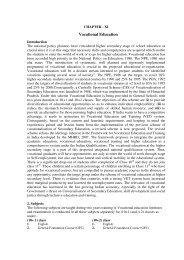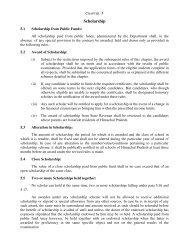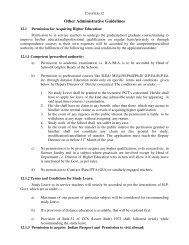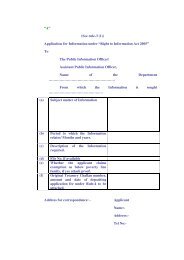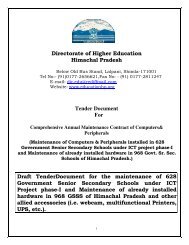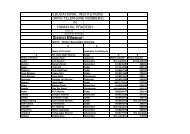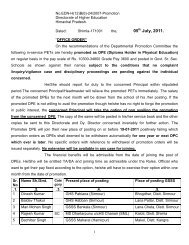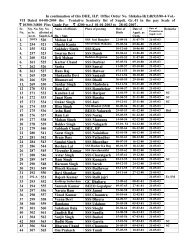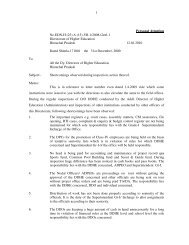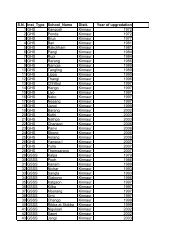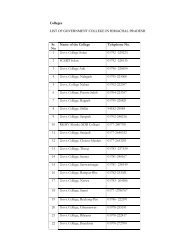Download - Department of Higher Education
Download - Department of Higher Education
Download - Department of Higher Education
Create successful ePaper yourself
Turn your PDF publications into a flip-book with our unique Google optimized e-Paper software.
CHAPTER - XI<br />
Vocational <strong>Education</strong><br />
Introduction<br />
The national policy planners have considered higher secondary stage <strong>of</strong> school education as<br />
crucial since it is at this stage that necessary skills and competencies are acquired which enable<br />
the students to enter the world <strong>of</strong> work or to go for higher education. Vocational education has<br />
been accorded high priority in the National Policy on <strong>Education</strong>, 1986. The NPE, 1986 inter<br />
alia states “The introduction <strong>of</strong> systematic, well planned and rigorously implemented<br />
programme <strong>of</strong> vocational education is crucial in the proposed educational re-organization.<br />
Vocational education will be a distinct stream intended to prepare students for identified<br />
vocations spanning several areas <strong>of</strong> activity”. The NPE, 1986 set the target, to cover 10%<br />
higher secondary students under vocational courses by 1990 and 25% by 1995. The POA, 1992<br />
reset the targets <strong>of</strong> diversification <strong>of</strong> students in vocational streams at +2 level to 10% by 1995<br />
and 25% by 2000.Consequently, a Centrally Sponsored Scheme (CSS) <strong>of</strong> Vocationalisation <strong>of</strong><br />
Secondary <strong>Education</strong> was launched in 1988, which was implemented by the State <strong>of</strong> Himachal<br />
Pradesh. Under this scheme Vocational <strong>Education</strong> is being provided in General Schools with<br />
two years duration in 10+1 and 10+2 classes. The objectives <strong>of</strong> this scheme are (i) to provide<br />
diversification <strong>of</strong> educational opportunities so as to enhance individual employability; (ii) to<br />
reduce the mismatch between demand and supply <strong>of</strong> skilled human resource, and (iii) to<br />
provide an alternative for those pursuing higher education. If India wants to have a competitive<br />
advantage, it needs to restructure its Vocational <strong>Education</strong> and Training (VET) system.<br />
Consequently, based on the current and futuristic requirements and keeping in mind the<br />
experiences gained and lessons learnt from the implementation <strong>of</strong> the previous scheme <strong>of</strong><br />
vocationalisation <strong>of</strong> Secondary <strong>Education</strong>, a revised scheme is now proposed. The revised<br />
scheme echoes the ideology inherent in the Framework for Vocational <strong>Education</strong> and Training<br />
in India developed by the MHRD, 2007. The framework proposes to integrate the general<br />
academic education, vocational education, vocational training and higher education as a<br />
comprehensive system under the Indian Qualifications. The vocational education at the higher<br />
secondary stage is a part <strong>of</strong> this proposed integrated national qualification system. Thus,<br />
vocational graduates will have opportunities not only to enter the world <strong>of</strong> work through wage<br />
or Self-employment, but also can have lateral and vertical mobility in the educational system.<br />
There is a significant drop-out <strong>of</strong> students after completion <strong>of</strong> Class 10 th and they do not join<br />
class 11 th . These children and a certain percentage <strong>of</strong> children enrolling in Class 11 th who have<br />
aptitude for vocational courses, but are compelled to pursue academic courses in the absence <strong>of</strong><br />
any opportunity, constitute the target group under the scheme <strong>of</strong> vocational education at higher<br />
secondary level. There is evidence that countries with a strong VET system have increased<br />
their marginal productivity and lowered the unemployment rates. The relevance <strong>of</strong> vocational<br />
education has increased in the fast growing Indian economy, especially in the light <strong>of</strong> the<br />
Government’s thrust on Universalisation <strong>of</strong> Secondary <strong>Education</strong>, skill development and social<br />
justice through inclusive education and training.<br />
2. Subjects<br />
The following subjects are taught during two years training in Vocational education institutes<br />
and examination is conducted in all these subjects separately for (10+1) and (+2) classes as<br />
under:-<br />
(10+ 1) class (10+2) class<br />
1. English. 1. English<br />
2. General Foundation Course (GFC) 2. General Foundation Course (GFC)



